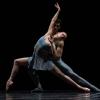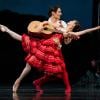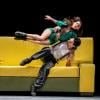
An odd couple proved great company Tuesday night as the San Francisco Ballet’s Program 4, running five times only, opened at the War Memorial Opera House with Martin West conducting. La Sylphide (originating in 1832), one of the oldest ballets extant, was followed by the West Coast premiere of Alexei Ratmansky’s The Seasons, which opened at American Ballet Theatre in 2019 as a tribute to the Russian’s first decade as its artist-in-residence.
What made both ballets roaring successes, aside from the obvious artistry of the dancers, was their humanity; La Sylphide, choreographed by August Bournonville to music by Herman Lovenskold, via the telling of an age-old romantic fable; The Seasons, music by Alexander Glazunov, to wit (as you may have guessed) spring, summer, fall, and winter, notes such ancient archetypes such as fauns, satyrs, and bacchantes, but is ultimately timeless.

And in this time of upheaval, what an appropriate break from worrying storms. Even the chill of winter cannot freeze the warmth of beauty and friendship, especially when two gnomes in brown tunics, waving red scarves, bring the fire. The barging-in is disruptive, but I contend that Alexei Ratmansky gnows his gnomes, and it works. Ratmansky digs the surprise of upheaval as well as the succor of harmony. Similarly, Robert Perdziola’s delightfully patterned and cut costumes, in vaguely seasonal hues (pastels for spring, chartreuse for fall, white for winter, orange, red, and black (‽) for summer, sometimes totally clash, one season bumptiously bumping on another. The impact is weirdly gorgeous.

As for Ratmansky as dancemaker, he remains a dream, and what he does, like all the best dreams, nearly defies description. We can talk about musicality and amplitude. We can admire the generous split jumps by Winter’s corps de ballet of Snowflakes. Or Spring’s springy, endless échappés and the lovely articulation of Wona Park’s rondes des jambes en l’air. But there’s also a pervasive sense of community up there on the stage. A notebook scribble: “all legs and comfort.” These seem to be people who like each other and enjoy dancing together, supporting and being supported. That was noticeable from Ratmansky’s first-ever work for SF Ballet, the 2003 Carnival of the Animals; let’s note here that Helgi Tomasson was among the first U.S. artistic directors to engage him.

Back then, I happened upon a rehearsal where it looked as if the dancers were having a party and pretending to be animals, and I so wanted to join them. That allure hasn’t changed, from Winter’s chill to the sunny finale, the entire company in a stunning tableau as if in a Broadway show, gathered cheek by jowl, arms wide, teeth flashing, colors clashing in sweetest style.
The terrific lead dancers were Tiit Helimets, Dores André, Yuan Yuan Tan, Sasha de Sola, and Madison Keesler in Winter; Angelo Greco, Elizabeth Powell and Park in Spring; Misa Kuranaga, Joseph Walsh, Cavan Conley, and Hansuke Yamamoto in Summer, and Isabella DeVivo and Benjamin Freemantle in Autumn. Joining Summer were young ladies in red with black tights, students from the San Francisco Ballet School nestling on the ground like perfect little red poppies, then rising to join in happy trios with the Cornflowers and Water Men.
(N.B.: When Putin began invading Ukraine, Ratmansky, who had been preparing a new project for the Bolshoi Ballet, where he was formerly artistic director, immediately left for New York. He said, according to The New York Times, that he will likely not return to Russia to work “while Putin is president.”)

And now, let us make a generous, Bournonville-style leap to La Sylphide. Tale as old as time, or pretty near it. The ballet, created in 1832 by Marie Taglioni’s father for his daughter to dance in, introduced the notion of romantic ballet, spirits wafting on pointe through the landscapes and chimneys of the exotic locale of Scotland, and characters like the Sylphide, or Sylph. August Bournonville, a Danish dancer, went to Paris to see the ballet and brought it back to the Royal Danish Ballet. It premiered in 1836, with the Levenskold music substituting for the original Jean Schneitzhoffer score. Bournonville, who was great at giant leaps and beating turns, also rechoreographed the ballet, giving himself plenty of solo work. Helgi Tomasson learned it as a student in Denmark and brought it to the San Francisco Ballet in 1986, the year after he became artistic director. Now it’s back, part of Tomasson’s preretirement victory lap.
Principal Dancer Ulrik Birkkjaer, who joined the company in 2017 from the Royal Danish Ballet, was James on Tuesday night. He’s been assisting in coaching the Sylphide dancers along with Tomasson, Anita Paciotti, and Katita Waldo. The Bournonville style is distinct and exacting, calling for “lightness, clarity, and elegance,” Tomasson notes. He could add, “and looking like it’s easy.”

It was great fun to watch Birkkjaer, who’s one of the taller dancers, flying through the air. But it was equally charming to see the blithe solos of Esteban Hernandez, in the role of the huntsman Gurn, who has a crush on Effie (Ellen Rose Hummel), who’s engaged to James, who’s in love with this Sylph (Sarah Van Patten).
As the curtain opens, James is snoozing in a chair by the fire, and the Sylph is sitting, enchanted, at his feet, her gauzy white costume and wings at odds with the dim, all-male hunting lodge environment, deer heads on the walls, tartan and tam on James. When James awakens, it’s from a dream of her. He’s done for; he spends the rest of the ballet eschewing his impending marriage to the lovely and smitten Effie, and roaming in the gloaming, looking for his Sylph — to his ultimate destruction.

Before the unhappy ending, which is somewhat ameliorated by the sight of the Sylph, gliding up to heaven by wire, but as if by magic, and by James, getting his comeuppance from the witch Madge (the noted Royal Danish Ballet teacher Eva Kloborg, guest artist), we’ve been able to glory in two acts, including a marvelous Highland reel for the corps de ballet, tartans flying; absolutely stunning solos and duets from Birkkjaer and Van Patten (whose fleet and floaty Bournonville artistry is merely her latest triumph), and a bubbly, letter-perfect folkdance turn by Hummel as the spurned — but then happily Gurn-ed—Effie. This is a ballet that makes you want to run away and learn Danish and move to Copenhagen. If you don’t like deer, they have wonderful salmon.
If you were there Tuesday, you may have seen choreographer Alexei Ratmansky rise to take a bow and unfurl a Ukrainian flag. More about that here. You likely also noticed a new, strange-looking front curtain in a sort of faded calico. It’s called the bow curtain, as in “taking a bow,’’ and was pressed into service when the regular curtain developed a mechanical glitch before the show. If our world hasn’t gone back to normal, at least the curtain will be.






